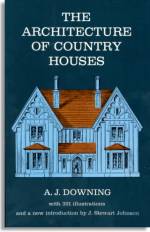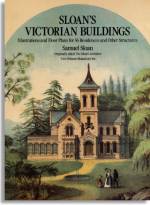
America's Victorian villas are visual reminders of the period from the 1830's to the 1870's, and the cultural, political, and industrial influences which produced these charming structures.
Although they followed to some extent the housebuilding fashions of the English upper-class of that era, there were a number of uniquely American trends embodied in the villas, as well. Because of the unpleasantness of the Revolution and the War of 1812, Americans sought to develop an identity different from that of England, and that impulse evidenced itself in many ways, from renaming foods, to simplifying elaborate Georgian architecture into more “honest” Federal designs, and eventually to the revival and adaptation of Greek forms in honor of the ancient Greek origins of republican political ideas.
Greek Revival architecture was utilized in lavish and simple forms for public buildings, churches, and homes. But within a generation, many style-setters pointed out that although the Greek designs might have some logic for governmental use, their pagan associations made them less than ideal for churches and their absolute symmetry made them uncomfortably rigid for use as homes. Architects therefore looked to the heavenward-soaring cathedral architecture of the middle ages and renaissance for spirit-inspiring vertical “Gothic” patterns, and to the welcoming informal countryside of Italy and the rambling, asymmetrical old houses of its gentry for more calming influences.

A major impetus for wealthy Americans to adopt the “country living” of villa homes was the perceived ugliness of the booming industrial cities. Fostering the cultural climate which made the villas stylish were the Romantic poets (especially Byron and Shelley, who were associated with Italy around 1820) and novelists (Washington Irving, James Fenimore Cooper, Sir Walter Scott), and the Luminist painters (who rediscovered and reinterpreted the earlier work of Claude Lorraine and Nicolas Poussin), examples being Thomas Cole and Frederick Edwin Church. Both Cole and Church included classical ruins in their “American” scenes, as they presented their artistic argument for reverence for the land. Others of the “Hudson River School” of painters, including Thomas Chambers, Frederick Rondel, and Robert Havell, Jr., incorporated into their landscape paintings the latest in villa designs.
The “Gothic” and “Italian” styles were tried on every type of building, including large and comfortable homes of the wealthy and nearly-so, built in both suburban and rural settings. These became known as “villas,” as opposed to the crowded “town houses” of the inner cities. Chief theorist Andrew Jackson Downing, in writing of this fashionably “picturesque” way of life, stated in his Architecture of Country Houses (p. 271) the definition: “A villa is a house surrounded by more or less land.” (See also Downing's Victorian Cottage Residences.)
Besides Downing (whose specialty was actually landscape design), villa proponents and designers included Samuel Sloan, Alexander Jackson Davis, Richard Upjohn, and John Notman in America; and A. W. N. Pugin, Charles Barry and John Nash (George IV's favorite architect) in Great Britain.

The first Gothic villa in America was Glen Ellen (see at right), built in 1832 near Towson, Maryland, by Alexander Jackson Davis for Robert Gilmor, III. Glen Ellen was modeled on Sir Walter Scott's Abbotsford on the River Tweed, Melrose, Scotland. Glen Ellen was demolished in 1929.
Another important early Gothic villa example, “Riverside,” was designed by John Notman as a home for Bishop George Washington Doane in Burlington, New Jersey. Design and construction dates are variously reported as between 1837 and 1846. (Riverside, demolished in 1961, had significant exterior features of the Italian style, below, in addition to its Gothic interior.)
Subcategories of the Gothic theme developed over the next two decades included “Swiss,” “Norman,” “Tudor,” and “Rhine.” The Gothic styles lingered as church and academic architecture, but as residential construction they were eventually supplanted by the Italian types.
The first purely “Italian” villa in the United States, Blandwood, in Greensboro, North Carolina, was constructed as an enlargement of North Carolina Governor John Motley Morehead's home by A. J. Davis in 1846. (An illustration of the new design had already been published in 1844.) In 1850 A. J. Downing published The Architecture of Country Houses, probably the single most influential treatise and pattern book for villas, containing numerous variations on both the Gothic and Italian themes.

Around 1855, Samuel Sloan introduced a steeper-roofed Italian style (in contrast to the already-popular flatter-roofed patterns, distinguished as “Tuscan”) with the house he built in Charlotte, North Carolina, for Governor Morehead's son John Lindsay Morehead (see illustration at right, and notes at the end of this page). Then, for another twenty-five years, the Italian villa genre was fully explored by numerous designers and builders, until finally the various signature embellishments became simply appliques on houses of all shapes, which as a result were called “Italianate.”
The Gothic villas typically had several high, steeply-pitched gables, with vergeboards (or “bargeboards”) decorating them. The Italian villas were known for their overhanging bracketed eaves, asymmetry, corniced window and door openings (often arch-topped), and in most instances a tower or a cupola. Both Gothic and Italian villas often had raised basements for service and family functions, and in general a floor plan designed for servant-supported family life and entertainment of friends. (Smaller Gothic and Italian examples, designed as auxiliary buildings, or as homes for the less affluent, were often called “cottages,” although the use of that term could also refer to a magnificant mansion built in a vacation spot.) Both Gothic and Italian villas usually had an exterior face of natural stone, or a flat wood surface (shiplap) which could be painted to suggest or imitate stone, or vertical (board-and-batten) siding. Italian villas sometimes were surfaced with stucco. Both Gothic and Italian villas usually incorporated one or more bay windows for a closer connection between the interior spaces and the natural world outside.
Writer John Maas (The Victorian Home in America, Hawthorn Books, Inc., New York, 1972) explains the picturesque and comfortable asymmetry of the Italian villas as follows:
The villa was “designed from the inside out;” as symmetry was not desired, the rooms could be scaled and grouped by function. The effect was said to be “elegant variety,” and the message of the villa was clearly: “This is the rich but not gaudy home of a gentleman of taste and culture.”

The Sims-Mitchell House (host of this cyber-guide) is a smaller and later (1875) example of the type of work Samuel Sloan did for J. L. Morehead in the mid-1850's, and is probably a derivative of a Sloan pattern. Of the typical Italian villa characteristics, it lacks only a tower and arch-topped windows and doors. Those simplifications probably merely reflect limitations of owner James Whittle's willingness to finance (and local contractor R. C. Saunders' ability to provide) extremely complex carpentry (see construction contract).
From the sponsors of this website.

Andrew Jackson Downing: The Architecture of Country Houses

Andrew Jackson Downing: Victorian Cottage Residences

Samuel Sloan: Sloan's Victorian Buildings
This website is sponsored by Mitchells Publications and the Sims-Mitchell House, Chatham, Virginia.
Copyright © 2001–2006 Patricia B. Mitchell.